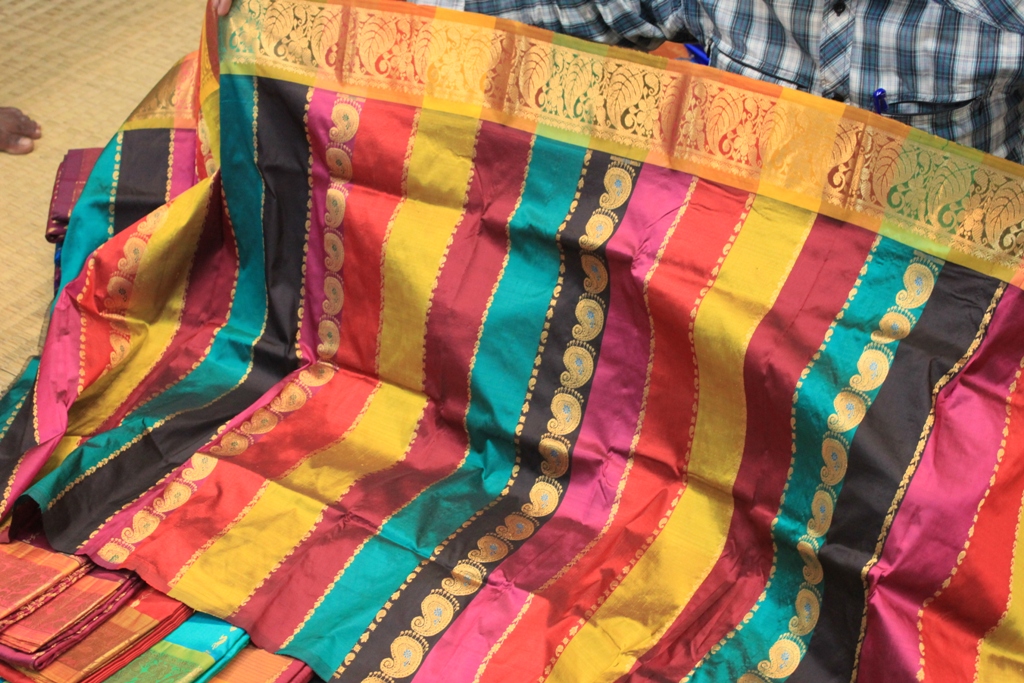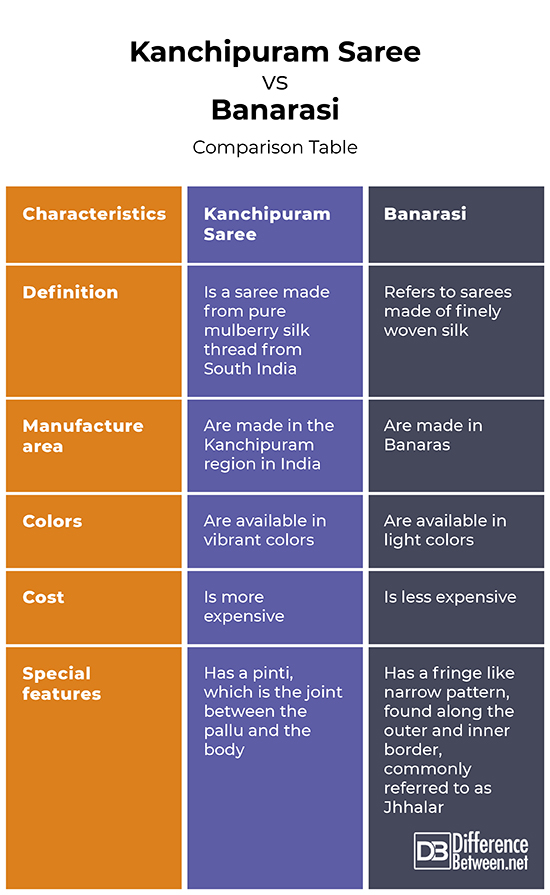Difference Between Kanchipuram Saree and Banarasi
Dating back to the Indus Valley Civilisation in the 2800- 1800BC, Sarees are the most common women’s garments in India. Although they can be worn in many styles, the most common style involves wrapping the saree around the waist and wearing a loose end of the drape over the shoulder, exposing the midriff. Other styles of wearing a saree include the Nivi, Bengali, Himalayan, Kodagu style, and Malayali style, just to name a few. There are many variations of sarees, which have gained popularity worldwide such as Kanchipuram saree and Banarasi. The two differ in several ways.
Kanchipuram Saree
Made in the Kanchipuram region in India, this is a silk saree worn on special occasions such as weddings and other celebrations. Woven from silver sari from Gujarat and pure mulberry silk thread from South India, the craftsmanship is just extraordinary. To increase stiffness and thickness, the silk thread used in the weaving is dipped in rice water and then sun-dried. Using a thin silver wire, the silk thread is then inter-locked, after which a golden thread is used.
These sarees are distinguished through their wide contrast borders and vibrant colors and derive their inspiration from scriptures and images from natural features and temples. The costs vary depending on colors, materials used, patterns and the intricacy of work.
The Kanchipuram saree is special because the pallu and the body are woven separately and then joined. A keen enough person can spot the area where the two join, commonly known as the pinti. Since three silk threads are used to make this, they tend to be heavy, but are durable and strong.
Banarasi
Made in Banaras, these are sarees made of finely woven silk. Inspired by the Mughal time, these sarees are available in light colors. They are well known for their silver brocade and gold, fine silk not to mention the opulent embroidery, and have various engravings, which makes them heavy.
Features include compact weaving, metallic visual effects, goldwork, the intricate intertwining of foliate and floral motifs as well as mina work. Their signature design is a fringe-like narrow pattern, found along the outer and inner border, commonly referred to as Jhhalar.
Due to the intensity of the details, a Banarasi saree can take up to six months to prepare. They are popular as bridal wear and during other important celebrations. Varieties of Banaras sarees include the Sattir, Kora, georgette and Katari.
Similarities between Kanchipuram saree and Banarasi
- Both are great outfits for an ethnic and classy look
- Both are made of silk
Differences between Kanchipuram saree and Banarasi
Definition
Kanchipuram saree is a saree made from pure mulberry silk thread from South India. On the other hand, Banarasi refers to sarees made of finely woven silk.
Manufacture area
While Kanchipuram sarees are made in the Kanchipuram region in India, Banarasi sarees are made in Banaras.
Colors
Kanchipuram saree are available in vibrant colors, Banarasi sarees are available in light colors.
Cost
Due to the thickness of the Kanchipuram saree, it is more expensive than Banarasi sarees.
Special features
Kanchipuram sarees have a pinti, which is the joint between the pallu and the body. On the other hand, Banarasi sarees have a fringe like narrow pattern, found along the outer and inner border, commonly referred to as Jhhalar.
Kanchipuram saree vs. Banarasi: Comparison Table
Summary of Kanchipuram saree vs. Banarasi
Kanchipuram saree is a saree made from pure mulberry silk thread from South India. It is available in more vibrant colors and has a pinti, which is the joint between the pallu and the body. On the other hand, Banarasi refers to sarees made of finely woven silk that is made in the Banaras region. They are available in light colors and have a fringe like narrow pattern, found along the outer and inner border, commonly referred to as Jhhalar.
- Difference Between Profit Center and Investment Center - July 2, 2022
- Difference Between Anti-Trust and Anti-Competition - June 6, 2022
- Difference Between Stocktaking and Stock Control - June 6, 2022
Search DifferenceBetween.net :
Leave a Response
References :
[0]Image credit: https://commons.wikimedia.org/wiki/File:Banarasi_sari_pallu_by_ashish4.JPG
[1]Image credit: https://live.staticflickr.com/7254/7642284350_7a26a5932d_b.jpg
[2]Nirmal Sengupta. Traditional Knowledge in Modern India: Preservation, Promotion, Ethical Access and Benefit Sharing Mechanisms. Springer Publishers, 2018. https://books.google.co.ke/books?id=ruBwDwAAQBAJ&pg=PA132&dq=Difference+between+Kanchipuram+saree+and+Banarasi&hl=en&sa=X&ved=0ahUKEwi5_PfGwdbmAhX4DGMBHSwzCFgQ6AEILTAB#v=onepage&q=Difference%20between%20Kanchipuram%20saree%20and%20Banarasi&f=false
[3]Jogdankar & Haridas. WORLD'S ECONOMIC AND COMMERCIAL GEOGRAPHY. Lulu.com Publishers. https://books.google.co.ke/books?id=78qaDwAAQBAJ&pg=PA401&dq=Kanchipuram+saree+and+Banarasi&hl=en&sa=X&ved=0ahUKEwi5vYCpwtbmAhWTBGMBHcv-ABsQ6AEIJjAA#v=onepage&q=Kanchipuram%20saree%20and%20Banarasi&f=false
[4]Dhar Banasi. Spunky Indian: January 2019 Issue (1st issue). Woven Words Publishers OPC Private Limited, 2019. https://books.google.co.ke/books?id=q36CDwAAQBAJ&pg=PA10&dq=Difference+between+Kanchipuram+saree+and+Banarasi&hl=en&sa=X&ved=0ahUKEwi5_PfGwdbmAhX4DGMBHSwzCFgQ6AEINTAC#v=onepage&q=Difference%20between%20Kanchipuram%20saree%20and%20Banarasi&f=false



